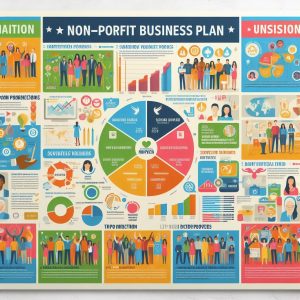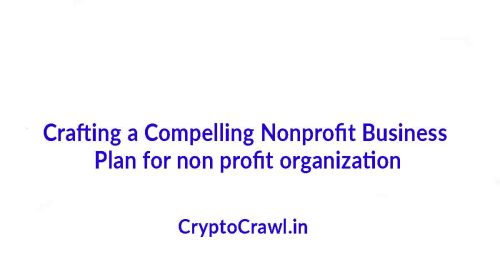Welcome, dear reader, to the journey of crafting a compelling business plan for your nonprofit organization. In the world of philanthropy and community service, having a well-thought-out business plan is akin to charting a course through uncharted waters. It not only serves as a roadmap for your organization but also communicates your mission, vision, and strategies to stakeholders. So, let’s embark on this adventure together, shall we?
Understanding Nonprofit Business Plans

Defining the Essence
A nonprofit business plan is more than just a document; it’s a blueprint that guides the actions and decisions of your organization. Unlike for-profit business plans, which primarily focus on generating revenue and profits, nonprofit business plans emphasize impact and sustainability.
Key Components of Success
At the heart of every compelling nonprofit business plan lies several key components. First and foremost is the executive summary, a succinct overview of your organization’s goals, strategies, and anticipated outcomes. Then, there’s the mission and vision statements, which serve as the North Star guiding your organization’s endeavors. Next, we have the organizational structure and management section, detailing the roles and responsibilities of key personnel. Programs and services come next, outlining the initiatives through which your organization fulfills its mission. Marketing and outreach strategies ensure that your message reaches the right audience, while financial projections and budgeting provide a roadmap for financial sustainability. Finally, evaluation and measurement of impact allow you to track your progress and make informed decisions.
Research and Analysis: Laying the Groundwork
Understanding Community Needs
Before setting sail, it’s crucial to understand the needs and challenges facing your community. Conducting comprehensive research, surveys, and interviews can help identify gaps and opportunities for intervention. By understanding the pulse of the community, you can tailor your programs and services to address real-world issues effectively.
Unlocking Potential with SWOT Analysis
A SWOT analysis—examining the strengths, weaknesses, opportunities, and threats facing your organization—can provide invaluable insights. By identifying internal strengths and weaknesses, as well as external opportunities and threats, you can develop strategies that capitalize on your strengths while mitigating potential risks.
Identifying Allies and Adversaries
No organization exists in a vacuum, and understanding the competitive landscape is essential. Identify potential collaborators and partners who share your mission and values, as well as competitors whose actions may impact your organization. By forging strategic alliances and partnerships, you can amplify your impact and reach new audiences.
Developing the Mission and Vision: Painting a Picture of Purpose

Crafting a Compelling Mission Statement
Your mission statement is the heartbeat of your organization—a concise declaration of your purpose and values. It should clearly articulate who you are, what you do, and why it matters. A well-crafted mission statement not only inspires stakeholders but also provides a guiding light for decision-making and strategic planning.
Aligning Vision with Action
While the mission statement defines your organization’s purpose, the vision statement paints a picture of the future you aspire to create. It encapsulates your long-term goals and aspirations, serving as a source of inspiration and motivation for your team and supporters. Aligning your vision with your mission ensures that every action you take brings you closer to your desired destination.
Building Programs and Services: From Vision to Action
Defining Core Initiatives
With your mission and vision in mind, it’s time to roll up your sleeves and get to work. Start by identifying core programs and services that align with your organization’s mission and address community needs. Whether it’s providing food to the hungry, education to underserved youth, or healthcare to the uninsured, your programs should be both impactful and sustainable.
Setting Goals and Objectives
Once you’ve defined your programs, it’s essential to establish clear goals and objectives for each initiative. What do you hope to achieve? How will you measure success? Setting SMART goals—specific, measurable, achievable, relevant, and time-bound—provides clarity and accountability, ensuring that your efforts yield tangible results.
Designing Implementation Strategies
With your goals in place, it’s time to develop implementation strategies that bring your programs to life. Consider the resources, partnerships, and logistics required to execute your initiatives successfully. Remember to involve key stakeholders in the planning process to garner support and buy-in from the outset.
Ensuring Scalability and Sustainability
As you launch your programs, keep an eye toward the future. How can you scale your impact and reach more people? Explore opportunities for growth and expansion while ensuring that your organization remains financially sustainable. Diversifying funding sources, cultivating donor relationships, and investing in capacity-building initiatives are key to long-term success.
Marketing and Outreach Strategies: Amplifying Your Message
Identifying Target Audiences
Effective marketing begins with a deep understanding of your target audiences—who they are, what they care about, and where they can be reached. Whether it’s donors, volunteers, clients, or community partners, tailor your messaging and outreach efforts to resonate with the needs and interests of your intended audience.
Crafting a Compelling Marketing Plan
A well-crafted marketing plan outlines the strategies and tactics you’ll use to reach your target audiences and achieve your organizational goals. From social media campaigns to email newsletters, events, and partnerships, leverage a mix of channels to amplify your message and engage stakeholders. Remember to track your marketing efforts’ effectiveness and adjust your approach as needed.
Leveraging Partnerships and Collaborations
Collaboration is the cornerstone of success in the nonprofit sector. Identify potential partners, influencers, and community leaders who can amplify your message and extend your reach. By forging strategic alliances and collaborations, you can tap into new networks, access additional resources, and amplify your impact exponentially.
Incorporating Storytelling and Branding
At the heart of every successful nonprofit is a compelling story—a narrative that resonates with stakeholders and inspires action. Share stories of impact, testimonials from beneficiaries, and anecdotes that bring your mission to life. Invest in building a strong brand identity that reflects your organization’s values and resonates with your target audience.
Financial Projections and Budgeting: Navigating Financial Waters
Estimating Income Streams
Financial sustainability is essential for the long-term viability of your organization. Start by estimating your income streams, including donations, grants, sponsorships, and revenue-generating activities. Be realistic in your projections and consider both short-term and long-term funding sources to support your programs and initiatives.
Projecting Expenses and Overhead Costs
Equally important is estimating your organization’s expenses and overhead costs. From programmatic expenses to administrative overhead, accurately forecasting your costs allows you to develop a balanced budget that aligns with your revenue projections. Remember to factor in both fixed and variable expenses and prioritize investments that directly support your mission and programs.
Creating a Realistic Budget
With your revenue and expense projections in hand, it’s time to create a realistic budget that ensures financial sustainability. Allocate resources strategically, prioritizing investments that align with your organizational priorities and goals. Be transparent and accountable in your financial management practices, providing stakeholders with clear insight into how their contributions are being used.
Exploring Funding Sources and Grants
In addition to individual donations and sponsorships, explore a variety of funding sources to support your organization’s work. Grants from government agencies, foundations, and corporations can provide significant financial support for your programs and initiatives. Be proactive in identifying funding opportunities and tailoring your grant proposals to meet the specific requirements of each funder.
ALSO-READ: Building an Effective Board of Directors for Nonprofit Organizations
Evaluation and Measurement of Impact: Charting Your Progress
Establishing Measurable Goals and Objectives
To gauge your organization’s success, it’s essential to establish measurable goals and objectives for your programs and initiatives. What outcomes are you seeking to achieve? How will you know if you’re making progress? By setting clear benchmarks and metrics for success, you can track your organization’s impact and make data-driven decisions.
Tracking and Evaluating Progress
Regularly monitor and evaluate your organization’s progress toward its goals and objectives. Collect data on key performance indicators, such as program reach, participant outcomes, and community impact. Use this data to assess the effectiveness of your programs, identify areas for improvement, and make informed decisions about resource allocation and strategy.
Using Data to Inform Decision-Making
Data-driven decision-making is essential for organizational success. Analyze your evaluation data to identify trends, patterns, and insights that can inform future strategy and planning. Share your findings with key stakeholders, including staff, board members, donors, and partners, to foster transparency and accountability.
Embracing Continuous Improvement
The journey toward impact is ongoing, and there’s always room for improvement. Embrace a culture of continuous learning and improvement within your organization, soliciting feedback from stakeholders, experimenting with new approaches, and adapting your strategies based on what you learn. By remaining agile and responsive, you can maximize your organization’s effectiveness and relevance.
Legal and Compliance Considerations: Navigating the Regulatory Landscape
Registering as a Nonprofit Organization
Before you can embark on your mission, you’ll need to formally establish your nonprofit organization. Depending on your location, this may involve registering with state or federal authorities, obtaining tax-exempt status, and fulfilling any other legal requirements. Consult with legal experts or nonprofit consultants to ensure compliance with relevant regulations.
Understanding Tax-Exempt Status and Regulations

One of the key benefits of operating as a nonprofit organization is tax-exempt status, which allows you to receive donations and grants without being subject to income tax. However, obtaining and maintaining tax-exempt status requires compliance with specific regulations and reporting requirements. Familiarize yourself with the rules governing nonprofit tax-exempt organizations to ensure compliance.
Compliance with Reporting Requirements
Nonprofit organizations are subject to various reporting requirements, including financial disclosures, annual filings, and compliance with donor restrictions. Stay abreast of your organization’s reporting obligations and deadlines, maintaining accurate records and documentation to support your filings. Failure to comply with reporting requirements can result in penalties and jeopardize your organization’s standing.
Risk Management and Liability Considerations
Operating a nonprofit organization entails inherent risks and liabilities, ranging from financial risks to legal liabilities and reputational risks. Develop a risk management plan that identifies potential risks, assesses their likelihood and impact, and outlines strategies for mitigation. Consider purchasing insurance coverage to protect your organization against unforeseen events and liabilities.
Writing and Formatting Tips: Crafting a Masterpiece
Keeping the Language Clear and Concise
When crafting your nonprofit business plan, strive for clarity and simplicity in your language. Avoid jargon and technical terms that may be unfamiliar to your audience, opting instead for plain language that can be easily understood by stakeholders of all backgrounds.
Using Visuals to Enhance Understanding
Visual elements such as charts, graphs, and infographics can help convey complex information more effectively than text alone. Incorporate visuals into your business plan to illustrate key concepts, trends, and data points, making it easier for stakeholders to grasp the information presented.
Seeking Feedback and Revisions
Don’t be afraid to seek feedback on your nonprofit business plan from trusted advisors, colleagues, and stakeholders. Incorporate their input and suggestions into your plan, refining and revising it until it accurately reflects your organization’s vision, goals, and strategies.
Finalizing the Business Plan Document
Once you’ve completed your nonprofit business plan, take the time to review and finalize the document. Ensure that it is well-organized, free of errors, and professionally presented. Consider printing physical copies for distribution to key stakeholders, as well as creating a digital version for online sharing and reference.
Conclusion
Congratulations, dear reader, on reaching the end of our journey together! Crafting a compelling nonprofit business plan is no small feat, but by following the steps outlined in this guide, you’re well on your way to success. Remember, a well-crafted business plan serves as more than just a roadmap—it’s a testament to your organization’s vision, values, and commitment to making a difference in the world. So, go forth with confidence, knowing that you have the knowledge and tools you need to navigate the challenges and opportunities that lie ahead. And may your journey be filled with purpose, passion, and impact. Safe travels!
ALSO-READS: Building an Effective Board of Directors for Nonprofit Organizations
